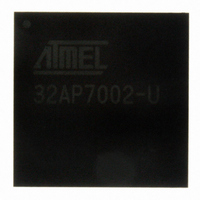AT32AP7002-CTUT Atmel, AT32AP7002-CTUT Datasheet - Page 249

AT32AP7002-CTUT
Manufacturer Part Number
AT32AP7002-CTUT
Description
IC MCU 32BIT AVR32 196-CBGA
Manufacturer
Atmel
Series
AVR®32 AP7r
Specifications of AT32AP7002-CTUT
Core Processor
AVR
Core Size
32-Bit
Speed
150MHz
Connectivity
EBI/EMI, I²C, MMC, PS2, SPI, SSC, UART/USART, USB
Peripherals
AC'97, DMA, I²C, LCD, POR, PWM, WDT
Number Of I /o
85
Program Memory Type
ROMless
Ram Size
32K x 8
Voltage - Supply (vcc/vdd)
1.65 V ~ 1.95 V
Data Converters
D/A 2x16b
Oscillator Type
Internal
Operating Temperature
-40°C ~ 85°C
Package / Case
196-CBGA
Data Bus Width
32 bit
Data Ram Size
32 KB
Interface Type
I2C, JTAG, PS2, SPI, SSC, UART, USART, USB
Maximum Clock Frequency
150 MHz
Number Of Timers
3
Maximum Operating Temperature
+ 85 C
Mounting Style
SMD/SMT
Minimum Operating Temperature
- 40 C
On-chip Dac
16 bit, 2 Channel
Package
196CTBGA
Device Core
AVR32
Family Name
AT32
Maximum Speed
150 MHz
Operating Supply Voltage
1.8|3.3 V
For Use With
ATAVRONEKIT - KIT AVR/AVR32 DEBUGGER/PROGRMMRATNGW100 - KIT AVR32 NETWORK GATEWAYATSTK1000 - KIT STARTER FOR AVR32AP7000
Lead Free Status / RoHS Status
Lead free / RoHS Compliant
Eeprom Size
-
Program Memory Size
-
Lead Free Status / Rohs Status
Details
Available stocks
Company
Part Number
Manufacturer
Quantity
Price
- Current page: 249 of 896
- Download datasheet (13Mb)
19.5.1
19.5.2
19.5.3
19.5.4
32054F–AVR32–09/09
Pull-up Resistor Control
I/O Line or Peripheral Function Selection
Peripheral A or B Selection
Output Control
Each I/O line is designed with an embedded pull-up resistor. The pull-up resistor can be enabled
or disabled by writing respectively PUER (Pull-up Enable Register) and PUDR (Pull-up Disable
Resistor). Writing in these registers results in setting or clearing the corresponding bit in PUSR
(Pull-up Status Register). Reading a 1 in PUSR means the pull-up is disabled and reading a 0
means the pull-up is enabled.
Control of the pull-up resistor is possible regardless of the configuration of the I/O line.
After reset, all of the pull-ups are enabled, i.e. PUSR resets at the value 0x0.
When a pin is multiplexed with one or two peripheral functions, the selection is controlled with
the registers PER (PIO Enable Register) and PDR (PIO Disable Register). The register PSR
(PIO Status Register) is the result of the set and clear registers and indicates whether the pin is
controlled by the corresponding peripheral or by the PIO Controller. A value of 0 indicates that
the pin is controlled by the corresponding on-chip peripheral selected in the ABSR (AB Select
Status Register). A value of 1 indicates the pin is controlled by the PIO controller.
If a pin is used as a general purpose I/O line (not multiplexed with an on-chip peripheral), PER
and PDR have no effect and PSR returns 1 for the corresponding bit.
After reset, most generally, the I/O lines are controlled by the PIO controller, i.e. PSR resets at
1. However, in some events, it is important that PIO lines are controlled by the peripheral (as in
the case of memory chip select lines that must be driven inactive after reset or for address lines
that must be driven low for booting out of an external memory). Thus, the reset value of PSR is
defined at the product level, depending on the multiplexing of the device.
The PIO Controller provides multiplexing of up to two peripheral functions on a single pin. The
selection is performed by writing ASR (A Select Register) and BSR (Select B Register). ABSR
(AB Select Status Register) indicates which peripheral line is currently selected. For each pin,
the corresponding bit at level 0 means peripheral A is selected whereas the corresponding bit at
level 1 indicates that peripheral B is selected.
Note that multiplexing of peripheral lines A and B only affects the output line. The peripheral
input lines are always connected to the pin input.
After reset, ABSR is 0, thus indicating that all the PIO lines are configured on peripheral A. How-
ever, peripheral A generally does not drive the pin as the PIO Controller resets in I/O line mode.
Writing in ASR and BSR manages ABSR regardless of the configuration of the pin. However,
assignment of a pin to a peripheral function requires a write in the corresponding peripheral
selection register (ASR or BSR) in addition to a write in PDR.
When the I/0 line is assigned to a peripheral function, i.e. the corresponding bit in PSR is at 0,
the drive of the I/O line is controlled by the peripheral. Peripheral A or B, depending on the value
in ABSR, determines whether the pin is driven or not.
When the I/O line is controlled by the PIO controller, the pin can be configured to be driven. This
is done by writing OER (Output Enable Register) and ODR (Output Disable Register). The
results of these write operations are detected in OSR (Output Status Register). When a bit in this
AT32AP7002
249
Related parts for AT32AP7002-CTUT
Image
Part Number
Description
Manufacturer
Datasheet
Request
R

Part Number:
Description:
DEV KIT FOR AVR/AVR32
Manufacturer:
Atmel
Datasheet:

Part Number:
Description:
INTERVAL AND WIPE/WASH WIPER CONTROL IC WITH DELAY
Manufacturer:
ATMEL Corporation
Datasheet:

Part Number:
Description:
Low-Voltage Voice-Switched IC for Hands-Free Operation
Manufacturer:
ATMEL Corporation
Datasheet:

Part Number:
Description:
MONOLITHIC INTEGRATED FEATUREPHONE CIRCUIT
Manufacturer:
ATMEL Corporation
Datasheet:

Part Number:
Description:
AM-FM Receiver IC U4255BM-M
Manufacturer:
ATMEL Corporation
Datasheet:

Part Number:
Description:
Monolithic Integrated Feature Phone Circuit
Manufacturer:
ATMEL Corporation
Datasheet:

Part Number:
Description:
Multistandard Video-IF and Quasi Parallel Sound Processing
Manufacturer:
ATMEL Corporation
Datasheet:

Part Number:
Description:
High-performance EE PLD
Manufacturer:
ATMEL Corporation
Datasheet:

Part Number:
Description:
8-bit Flash Microcontroller
Manufacturer:
ATMEL Corporation
Datasheet:

Part Number:
Description:
2-Wire Serial EEPROM
Manufacturer:
ATMEL Corporation
Datasheet:











